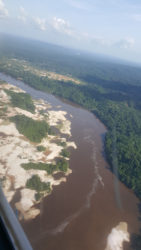Despite several attempts by Stabroek News, the Guyana Geology and Mines Commission (GGMC) has remained mum about reported damage to riverbanks by miners.
In a letter published in Stabroek News (SN) on November 29, Major General (Retd), Joseph Singh said that on October 17, he informed the relevant regulatory and enforcement agencies about damage on the Potaro and Essequibo rivers and submitted the photographic evidence.
He was informed that actions would be taken to deal with the obvious breaches of the regulations.
When Stabroek News attempted to contact GGMC Commissioner, Newell Dennison last week for comment it was told by his secretary that he does not see anyone without an appointment but the secretary nevertheless informed him that a reporter was there to see him.


The secretary returned and said he was in a meeting and that he would be discussing the matter with his managers before he can make a comment on the issue.
On November 27, 2016, through an aerial view, Singh, a former Chairman of the GGMC, said he observed that the indiscriminate mining of river banks and also the dumping of tailings in the channels were not confined to the Potaro and Essequibo Rivers, but were taking place in the middle Cuyuni (just below the confluence of the Ekereku River with the Cuyuni River), in the Wenamu River (on both the Guyana and Venezuela banks), in the Ekereku River (opposite the Ekereku Airstrip), and in the middle Mazaruni River (below Tamakay Landing).
The situation in the Potaro and Essequibo Rivers has also worsened on the right and left banks of the Potaro River and on the left bank of the Essequibo River by Omai Landing, the letter stated.
Contacted about the mining, Executive Director of the Guyana Gold & Diamond Miners Association (GGDMA), Edward Shields, told SN that Singh is an advisor to President David Granger while another former head of the Guyana Defence Force is in charge of advising on the environment.
As such he said the GGDMA was “confused as to the reason” why he [Singh] went to the media. “He is from within the government and he has the power to take action within the administration.”
He surmised that: “Obviously he is not getting any action…. It means that their views are not Qaccepted by the administration. Is he trying to embarrass the administration? And that is our position.”
With regards to the degradation of the riverbanks that Singh mentioned, he said, “He [Singh] has been saying that for the last 20 years.”
He admitted that “mining disturbs the environment” but said, “Why you’re attacking the miners is beyond our comprehension. There are laws in place to prevent what he is speaking about. He needs to attack the GGMC [Guyana Geology & Mines Commission], not the miners… Ask the officers at GGMC why they are not implementing the environmental laws and stop blaming the miners.
Shields pointed out that the environmental regulations were established in 2005 and questioned why they are not being complied with.
Singh stated in the letter that erosion has been occurring on the banks of the Potaro and Essequibo Rivers between Tumatumari and Omai.
He stated too that he also has photographic evidence of “heavy sediment loading of the Cuyuni River (from the cumulative impact of mining activities in the upper Cuyuni located in Venezuela, and in the middle and lower Cuyuni River in Guyana) at its confluence with the Mazaruni River by Kartabu Point.”
Singh noted that the regulatory and law enforcement agencies, some of which actually have personnel deployed within striking distance of the impacted areas, cannot be unaware of these breaches.
Added to the mining illegalities, he said, are the build-up of detritus (human waste and abandoned mining camps and equipment), indiscriminate dumping of tailings, which prove to be “hazards to navigation in the rivers, deterioration of the quality of fresh water for downstream communities and the degradation of aquatic life.”
He said too that the impacts of the mining activities on river banks such as on the left bank of the Cuyuni River below Ankoko Island, and on the river channel of the Wenamu River also have strategic implications as these apply to the delineation of the international border.
Recognizing the contribution of the gold mining community to the development of Guyana and Guyanese, Singh said “the pioneering efforts, courage, risk-taking and technological advances initiated by miners and services providers in the mining sector, are to be applauded.”
However, he pointed out that “mining operations in our rivers or contiguous land areas have to be compliant with the regulations, including those relating to the health and safety of mining crews and downstream communities and for the sustainability of ecosystems and services.”
He said he had “reported to the authorities on aberrations in the gold mining operations in our rivers and contiguous land areas six weeks ago. I have not seen any evidence of any reduction of these breaches but more alarmingly, I have witnessed the escalation of breaches and on a much wider scale.”
“Through this medium,” he said, “I am appealing to the mining community, the regulatory and enforcement agencies and the affected communities to work collaboratively to put a stop to this madness which, if unchecked, will contradict our efforts at sustainable development through a green economic pathway, compromise our stewardship of Guyana’s natural capital, and undermine the integrity of our legacy to future generations.”









